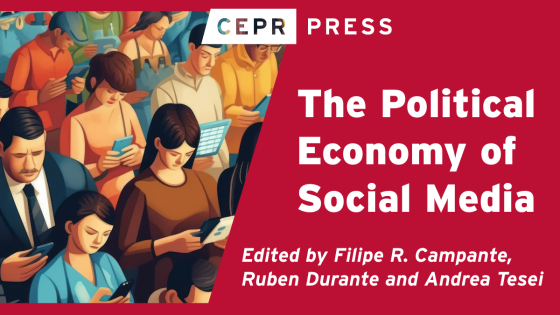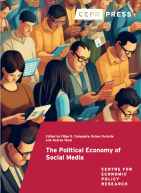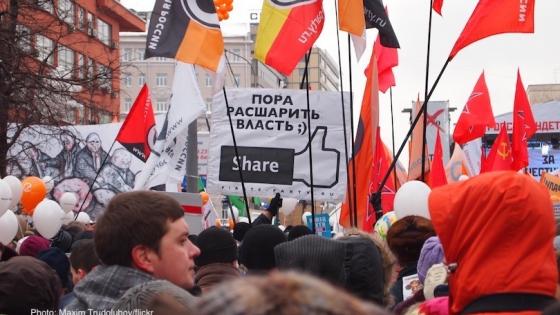The first broad conclusion can be stated simply: social media has indeed represented a massive shock to political systems worldwide. The voluminous evidence on the impact of 20th century legacy media on political outcomes (surveyed by, among others, Prat and Stromberg 2015) already warranted a strong prior that the radical scale of change brought about by the Internet, and by social media in particular, was bound to have major consequences on politics. Still, as we argue in our introduction to the eBook, the evidence accumulated so far indicates that the impact of social media has had unique characteristics, even compared to prior transformations.
This unique impact can be largely traced to technological features that distinguish social media from its mass media predecessors: its ubiquity, the low (essentially negligible) barriers to entry that its poses in the production and dissemination of content, and its disproportionate propensity to connect like-minded individuals.
On the first point, while some of the earlier mass media technologies eventually became portable (e.g., radio) and arguably had addictive properties (e.g., television), social media can be carried around and exert its pull on consumers literally anywhere, anytime, via mobile phones. This ubiquity entails a broader scope for impact on everyday life and human welfare. Both experimental and observational evidence (Allcott et al. 2022, Braghieri et al. 2022) has established that social media usage may have negative effects on subjective wellbeing, and that it displays features of addictive behaviour – which means that its widespread usage cannot be taken as prima facie evidence that users benefit from it on net. This suggests that there is scope for considering regulation of social media usage and for encouraging content moderation on online platforms.
While the ubiquity sets the stage for the possibility, and even likelihood, of large effects on political behaviour and outcomes, the features that are most responsible for making those effects unique, when compared to other mass media technologies, are the low barriers to entry in the production and dissemination of content, and the propensity for like-minded (homophilic) networks. Quite simply, in the context of social media, every user is a content provider as well as a consumer. This is in stark contrast to radio or TV, which are largely one-way avenues where a (relatively) small number of outlets broadcast content for a mass audience.
The first implication of these features that they create an unprecedentedly vast amount and diversity of content. In managing this vastness, individuals are likely to gravitate towards like-minded content they find agreeable – which importantly includes what like-minded individuals agree in finding outrageous. The second implication is that social media offers equally unprecedented opportunities for coordination and collective action. This can greatly empower citizens but, critically, also empowers politicians and political actors in general, who can use it to achieve wide-ranging strategic goals, from the desirable to the destructive.
Against this broad canvas, the empirical evidence collected in the eBook highlights how these forces influence different aspects of the political landscape, from electoral outcomes to political mobilisation and beyond.
With regards to voters in democratic elections, there is evidence that, as often speculated, the spread of social media has led to lower levels of trust in government and support for populism (Guriev et al. 2021, Manacorda et al. 2023) and greater polarisation (Levy 2021). As for politicians, there is evidence that the low barriers of entry allowed by the technology have been strategically exploited by political outsiders (Campante et al. 2018), although in some cases social media can also work against them (Fujiwara et al. 2021).
Social media can also be an effective tool for coordinating and facilitating costly collective action (Campante et al. 2022). This role in fostering political mobilisation has been established in a variety of different contexts, ranging from Russia to Africa and beyond (Enikolopov et al. 2020, Manacorda and Tesei 2020, Fergusson and Molina 2021). This can also have a dark side, as social media has been used to facilitate xenophobic actions and the spread of hateful messages (Bursztyn et al. 2019, Muller and Schwartz 2020).
The role of social media in empowering citizens and politicians poses specific tensions in the context of autocracies, and on this front few cases are as important as that of China. The research in the eBook illustrates how the Chinese government has taken to harnessing social media environments through direct action and monitoring (Qin et al. 2017), while facing the key trade-off between social media as a source of valuable information and as a perilous arena from the standpoint of facilitating collective action against the regime.
We also argue that to understand the impact of social media requires dealing with its indirect effects, as it exerts a powerful influence on other media. The evidence in the eBook showcases how social media shapes what other outlets cover, and how it does this (Hatte et al. 2022, Cagé et al. 2022). In this way, its influence goes far beyond its immediate reach, further amplifying its ubiquity.
In sum, the impact of social media is wide-ranging and multifaceted: it can empower voters and politicians, citizens and autocrats; increase participation or decrease it; bring people together or push them apart. Far from providing simple answers regarding whether social media is ‘good’ or ‘bad’, the work compiled in this eBook establishes that the implications can push in different directions, depending on different outcomes and contexts.
One thing that remains a crucial, open topic for future research is what to do about social media from a policy perspective. How can we harness their potential and minimize their harm? In contrast with many addictive goods that bring little social upside beyond individual enjoyment – and whose consumption, for the most part, we would therefore like to discourage – social media can also have positive effects that are not fully internalized by individuals. This makes it difficult to figure out what optimal regulatory policy should be, and how to achieve it.
Some possible directions are already apparent. To give but one example, the evidence in the chapter by Ro’ee Levy indicates that the algorithms employed by social media companies play an important role in the impact of social media usage on polarisation. Regulating them, or changing the incentives that underpin their design, seems worthy of consideration by policymakers. By the same token, the chapters in Section 7 of the eBook underscore that social media strongly conditions what happens on traditional media platforms, and this interplay should affect how policy approaches the regulation of those platforms.
In any case, more research is needed to guide policy. Yet there are substantial challenges to pushing research in this direction. For one, social media has become ubiquitous, and the kind of exogenous variation in access exploited by some of the contributions covered here – the spread of broadband or 3G access, or idiosyncrasies in the initial expansion of certain platforms – is, by now, hard to come by. The experimental approach that other contributions have used is a natural alternative, but this generally precludes the kind of large-scale, general-equilibrium impact that is often the object of policy interest.
Yet the importance of the questions associated with these issues is bound to keep drawing intense attention from researchers going forward. One recent set of examples, published too late to be incorporated as in the eBook, is provided by the series of collaborations between teams of social scientists and social media companies for large-scale experiments (González-Bailón et al. 2023, Guess et al. 2023a, 2023b, Nyhan et al. 2023). The results have shed light on the power and limitations of algorithms and user features, the degree of segregation in news consumption, and the limits of its effects on polarisation. At the same time, these studies are bound to raise further questions that will continue to stimulate research going forward.
Authors’ note: This column draws heavily on the introductory chapter of the eBook reproducing several segments of the text.
References
Allcott, H, M Gentzkow, and L Song (2022), “Digital Addiction”, American Economic Review 112(7): 2424-2463.
Braghieri, L, R Levy, and A Makarin (2022), “Social media and mental health”, American Economic Review 112(11): 3660-3693 (see also the Vox column here).
Bursztyn, L, G Egorov, R Enikolopov and M Petrova (2020), “Social Media and Xenophobia: Evidence from Russia”, CEPR Discussion Paper No. 14877.
Cagé, J, N Hervé, and B Mazoyer (2022), “Social Media Influence Mainstream Media: Evidence from Two Billion Tweets”, CEPR Discussion Paper DP17358 (see also the Vox column here).
Campante, F, R Durante and F Sobbrio (2018), “Politics 2.0: The Multifaceted Effect of Broadband Internet on Political Participation”, Journal of the European Economic Association 16(4): 1094-1136.
Campante, F, R Durante, and A Tesei (2022), “Media and Social Capital”, Annual Review of Economics 14: 69-91.
Campante, F R, R Durante and Andrea Tesei (eds) (2023), The Political Economy of Social Media, CEPR Press.
Enikolopov, R, A Makarin, and M Petrova (2020), “Social Media and Protest Participation: Evidence from Russia“, Econometrica 88(4): 1479–1514 (see also the Vox column here).
Fergusson, L and C Molina (2021), “Facebook causes protests”, Documento CEDE 018002, Universidad de Los Andes.
Fujiwara, T, K Müller, and C Schwarz (2021), “The Effect of Social Media on Elections: Evidence from the United States”, working paper.
Ghonim, W (2012), Revolution 2.0: The Power of the People is Greater than the People in Power: A Memoir, Houghton Mifflin Harcourt.
Guess, A M, N Malhotra, J Pan et al. (2023), “How do Social Media Feed Algorithms affect Attitudes and Behavior in an Election Campaign?”, Science 381(6656): 398-404.
Guess, A M, N Malhotra, J Pan et al. (2023), “Reshares on Social Media amplify Political News but do not detectably affect Beliefs or Opinions”, Science 381(6656): 404-408.
Guriev, S, N Melnikov and E Zhuravskaya (2021), “3G Internet and Confidence in Government”, Quarterly Journal of Economics 136(4): 2533-2613.
Haidt, J (2022), “Why the Past 10 years of American life have been uniquely stupid”, The Atlantic, 11 April.
Hatte, S, E Madinier, and E Zhuravskaya (2022), “Reading Twitter in the Newsroom: Web 2.0 and Traditional-Media Reporting of Conflicts”, CEPR Discussion Paper DP16167.
Levy, R (2021), “Social media, news consumption, and polarization: Evidence from a field experiment”, American Economic Review 111(3): 831–70.
Manacorda, M and A Tesei (2020), “Liberation Technology: Mobile Phones and Political Mobilization in Africa”, Econometrica 88(2): 533–567.
Manacorda, M, G Tabellini, and A Tesei (2023), “Mobile internet and the rise of communitarian politics”, CEPR Discussion Paper No. 18063.
Müller, K and C Schwarz (2020) “From hashtag to hate crime: Twitter and anti-minority sentiment”, conditionally accepted at AEJ: Applied Economics.
Nyhan, Brendan, J Settle, E Thorson et al. (2023), “Like-minded Sources on Facebook are Prevalent but not Polarizing”, Nature 620(7972): 137-144.
Prat, A, and D Strömberg (2013), “The Political Economy of Mass Media”, Advances in Economics and Econometrics 2: 135-187.
Qin, B, D Strömberg, and Y Wu (2017), “Why does China allow freer social media? Protests versus surveillance and propaganda”, Journal of Economic Perspectives 31(1): 117-40 (see also the Vox column here).







